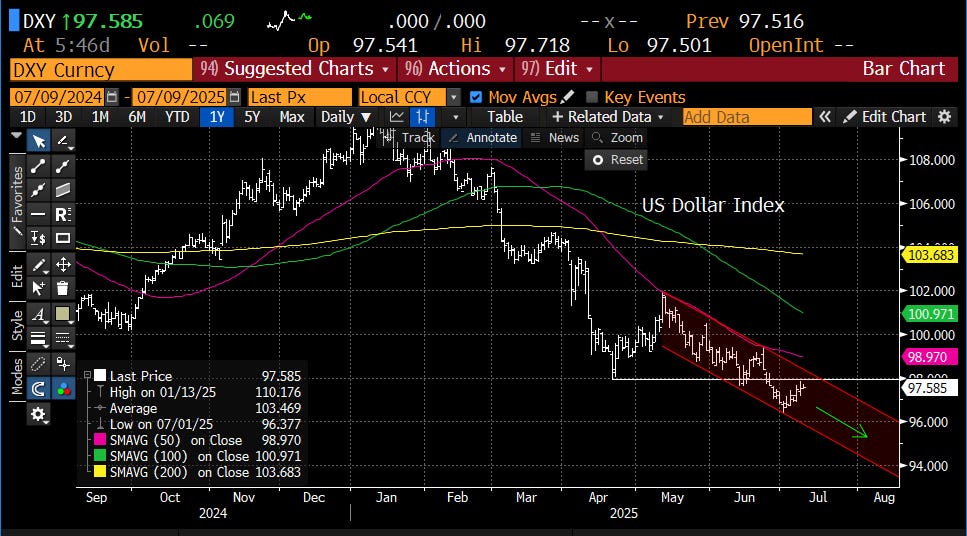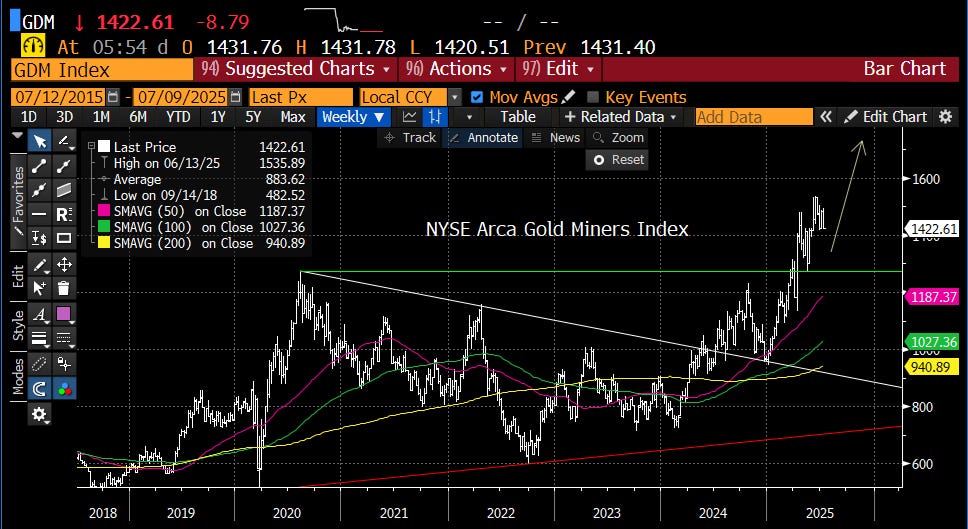MAD Macro - You've Got Mail
TACO Tariff Man Is Back in Action
The TACO Tariff Man Wants Us to Send Letters
Another Vacation Special Edition. The Next Regular MAD Macro Will Be Monday 7/14
TACO Tariff Man is back in action. He is bigger and stronger than ever. The market could care less about the TACO Tariffs. Investors are counting on TACO Trump. TACO Tariff Man is tired of his guys trying to negotiate trade deals so he is sending letters. So the entire world’s got mail. It might not be the mail they wanted but they’ve got mail. Trump changed the rules, the letters will count as trade deals. It’s his way or the highway. Speaking of tariffs, TACO Tariff Man is imposing a 50% tariff on copper. Not surprisingly copper rallied 10% on the news to new all-time highs. Watch out for the gutter thieves, they are coming after your copper gutters. Oh, by the way, if you have a copper roof, watch out.
Thankfully, Trump finally realized that Pootie is not his friend. Sadly, it might be too late for Ukraine. Russia is advancing and might have Odessa before the cold weather arrives this fall. Crude oil rallied on the news that Trump might finally impose economic sanctions on Russian energy exports. Tucker will be upset, that’s the good news. Crude oil might stay in a trading range between $65 and $80 as Trump imposes energy sanctions on Russian energy exports. OPEC is meeting this week and is expected to continue increasing output but they are approaching the end of the possible output increases.
Jason Riley has a very good opinion article in today’s WSJ, linked here. It’s titled, “Trump Is on a Roll, but He Shouldn’t Get Overconfident”. Jason points out that deficits and tariffs are both a risk to the economy and to Trump’s winning streak. Speaking of the deficit problem, there are two more interesting articles on the subject in today’s papers. One, by William Galston, is in today’s WSJ, linked here. It’s titled, “Make America Solvent Again”. He points out Lawrence Summers’ legitimate criticism of the BBB’s deficit spending. The second article on the deficit is by Jared Bernstein in today’s NYT, linked here. It’s titled, “Biden’s Chief Economist: The Chart That Convinced Me Our Debt Is a Serious Problem”. This article is revealing. Jared was partly responsible for the debt problem Biden created when he expanded the deficits in a growing economy. Really Jared, now your convinced by one chart that there is a problem? Please, your fiscal expansion in a growing economy triggered the higher inflation that triggered the higher interest rates. Now he is worried. I included the chart that changed Jared’s view of deficits below.
Markets continue to ignore the risks of tariffs and deficits. I am not sure what will change the market except that I don’t think it will be able to ignore the tariff and deficit risks for much longer. The markets are close to unchanged this morning. Copper is a little lower but is holding on to most of yesterday’s 10% rally.
I updated the U.S. Dollar Index, U.S. 10yr yield, U.S. 10yr-2yr yield spread, WTI crude oil, NY copper, spot gold, NYSE Arca Gold Miners Index, bitcoin, Strategy, S&P futures, NASDAQ 99 futures and DOW futures charts below.
The dollar and interest rates are close to unchanged. The curve steepen a little yesterday. Watch the curve for signs that the markets are becoming worried about deficits.
Crude oil is unchanged and copper is a little lower but still trading at new all-time highs. Spot gold is a little lower testing a trend line that I think will hold. The NYSE Arca Gold Miners Index should open close to unchanged. Bitcoin is a little higher, trading near all-time highs. Strategy is unchanged.
S&P, NASDAQ 99 and DOW futures are all slightly higher.
IMPORTANT DISCLOSURES AND DEFINITIONS
Unless otherwise stated, Bloomberg is the source of all data and charts.
S&P 500 futures are a type of derivative contract that provides a buyer with an investment priced based on the expectation of the S&P 500 Index’s future value. Nasdaq 100 futures are commodities futures products traded within the equity futures sector. West Texas Intermediate (WTI) oil is a benchmark used by oil markets, representing oil produced in the U.S. Brent Crude Oil is a blend of crude oil recovered from the North Sea in the early 1960s, whose price is used as a benchmark for the commodity's prices. The U.S. dollar index (USDX) is a measure of the value of the U.S. dollar relative to the value of a basket of currencies of the majority of the U.S.'s most significant trading partners. UBS Bloomberg Constant Maturity Commodity Index is a total return rules-based composite benchmark index diversified across commodity components from within specific sectors. Index performance is not illustrative of fund performance. It is not possible to invest directly in an index.
The information herein represents the opinion of the author(s), an employee of the advisor, but not necessarily those of VanEck. The securities/ financial instruments discussed in this material may not be appropriate for all investors. The appropriateness of a particular investment or strategy will depend on an investor’s individual circumstances and objectives.
This material has been prepared for informational purposes only and is not an offer to buy or sell or a solicitation of any offer to buy or sell any security/financial instrument, or to participate in any trading strategy.
Certain statements contained herein may constitute projections, forecasts and other forward looking statements, which do not reflect actual results, are valid as of the date of this communication and subject to change without notice. Information provided by third party sources are believed to be reliable and have not been independently verified for accuracy or completeness and cannot be guaranteed. VanEck does not guarantee the accuracy of third party data.
All investing is subject to risk, including the possible loss of the money you invest. As with any investment strategy, there is no guarantee that investment objectives will be met and investors may lose money. Diversification does not ensure a profit or protect against a loss in a declining market. Past performance is no guarantee of future performance.


















